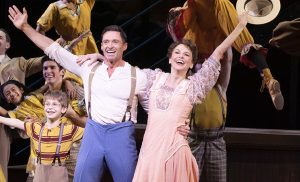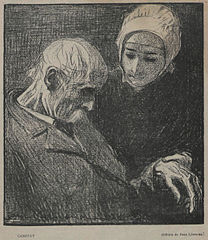It’s Monday. (I feel very witty when I say things that appear obvious.) There are twists and turns every Monday and this week the small twist is that I’m actually writing this on Monday. Normally I write my Monday blog post very early Tuesday morning, and still post it on US Monday but today… I have nine minutes now and no time then for two hours and then a full hour before midnight, so I’m writing my Monday post on Monday.
The second twist (the big one) is that I’ve only read a bit of the book I’m introducing you to. I don’t have time to finish it right now, and I’m too excited by it to wait to write about it.
There’s a story behind why it’s open on my machine. Of course there’s a story. Someone very proudly told me that Mary Shelley’s Frankenstein wasn’t the first work of science fiction. They claimed something from the eighteenth century as the first. I instantly wanted to argue, because the eighteenth century is too early and too late. Approaches matter, and there are at least half a dozen different arguments for this work or that work to be considered science fiction.
It all rests on definitions. What is science fiction? What is fantasy? Are we only talking about modern novels, or are we talking about other types of narrative? There’s a terrific Medieval life of Alexander, where Alexander explores underwater in a bathysphere and loses to the Amazons when he invades and is fed dinner by them and… I talked about it just the other day at a science fiction convention. It’s not one book. It’s many different types of stories in many different books. It’s also very well studied, even though it’s not known nearly well enough in some science fiction circles. Here’s a bibliography prepared by people who know more about it than me (I’ve read two versions, only.)
One can go back further than that, much further, or go forward. There are stories in many languages and from several continents. The trick is to start looking.
Two days ago I decided to look for French books from the seventeenth century. I already know the work where Cyrano goes to the Moon, and it’s fun, but where one book like that is written, there must be others. I used to know several others, but my brain sometimes forgets everything (I think it does it on purpose, to annoy me) so I looked again. I found several things I once had known, and one single book that’s new to me and that’s surprisingly close to home in a number of ways. It’s the one I want to read when I do not have time.
It’s the story of a voyage to Australia. It was published in 1732. Australia was known to many people by then, not least of all the people who had already been living here for the last tens of thousands of years, but Europe, for the most part, thought of it as unknown and exotic. Bits of it had appeared on European maps, and the region now known as South East Asia had contacts, especially up north. So did all the region north of Australia (Papua and PNG in modern parlance), and quite possibly New Zealand and maybe even China. But Europe didn’t pay much attention to what most of these places thought of the southern continent and was only just in the throes of making its own discoveries.
When I was at school, I was taught that there was no knowledge of Australia in Europe until the eighteenth century. Since then, however, the maps from the Dutch and Portuguese have demonstrated very much otherwise. Parts of Australia have been known to parts of Europe since at least the fifteenth century. Here is a map that reflects stuff from an earlier map, to show what was known to those Europeans who had access to this very specialised knowledge.
Of course, contact with Australia from nearby places dates back long before then. One of my students a few years ago was Indonesian and her family had stories about contact with Australia. We visited an exhibition at the National Museum and she was able to point to her island and then to where people from her island travelled to, for trade. How long has that trade been happening? I need to check out archaeological studies, her island began regular contact with northern Australia a long time before Europeans even thought to come to the Great Southern Land.
Before those early maps from Europe, there was talk about Australia. In fact, Europeans have been talking about Australia since at least the time of Cicero. Cicero wrote about it in his science fictional “Somnium Scipionis” (“The Dream of Scipio”), which was part of his De Re Publica where Scipio Africanus went to Mars and saw the world laid out. Australians were there as antipodeans, people who walked on the opposite side of the earth. Macrobius took that dream in the fifth century and wrote commentaries on it and those commentaries were used as geographical explanations throughout the Middle Ages.
A fictional account of someone voyaging to Australia in the seventeenth century has, therefore, a really solid background. It was a story based on things other people knew and accepted. That’s why I want to read it. I want to know what people thought about this country at a time when most Europeans saw it as an intellectual conceit or a place only specialist traders knew about.
The preface explains that the writer knew a fair amount about modern (for that time) geography. He makes it very clear that he’s not talking about Java, nor about the Americas. He even names explorers to demarcate their routes and interests. To me, this is the stuff that science fiction is made of. Take current knowledge (proving one’s cutting edge understanding) and then extrapolate and write fiction inspired by it. The extrapolation is invention, and it says more about Europe than about Australia, but it’s no less interesting for that. It describes an invented Australia in the year 1610. The land, the writer says, is more fertile and more populated than Europe.
Now you know why I want to read it. I wish I had time. It’s on my computer, however, and if ever an excuse arises (if someone tells me “I want a talk about this book” or “Give me an article”) then I shall be very grateful to Professor Ron Ridley who gave me the capacity to read seventeenth century French. Let me tell you about that, and then sign off, because it’s heading for midnight here and I do like the thought of finishing my Monday post on Monday itself.
I was doing third year History, as an undergraduate, and I’d been allowed into a fourth year class on Roman historiography, because it wasn’t going to be offered the following year. Ridley noted that I was doing historical French as another subject, and set me an essay that used it. I had to read and analyse 22 volumes of seventeenth century French in a collection of rare books, with only one article about them (in modern French) to help me. It was a lot of work. So much work… By the end of it, I could read seventeenth century French perfectly well. Even if I have no other skills to my name, I have this one. And now that these early novels are available on the web, I have a reason to rediscover that odd little skill of mine. All I need is someone to give me an excuse…

 Certain shows (I’ll spare you the list) lodge deep under my skin–The Music Man, which I saw last week on Broadway, being one. I grew up with the cast album (Robert Preston and Barbara Cook) and the film (Robert Preston and Shirley Jones). I had never seen it staged, however, so when the opportunity arose to see a revival with Hugh Jackman and Sutton Foster, I leapt at it, credit card in hand. I want first to say that I liked it a lot. That being said…
Certain shows (I’ll spare you the list) lodge deep under my skin–The Music Man, which I saw last week on Broadway, being one. I grew up with the cast album (Robert Preston and Barbara Cook) and the film (Robert Preston and Shirley Jones). I had never seen it staged, however, so when the opportunity arose to see a revival with Hugh Jackman and Sutton Foster, I leapt at it, credit card in hand. I want first to say that I liked it a lot. That being said… A couple of weeks, I wrote about the importance of taking a break from the war news. Being able to step away is indeed a privilege. Ukrainians can’t take a break in the same way that I, living in a nation not at war, can. They may have times when life goes on as usual, depending on where they live, but somewhere else in their own country, cities are being pulverized and ordinary people are the victims of terrorist attacks.
A couple of weeks, I wrote about the importance of taking a break from the war news. Being able to step away is indeed a privilege. Ukrainians can’t take a break in the same way that I, living in a nation not at war, can. They may have times when life goes on as usual, depending on where they live, but somewhere else in their own country, cities are being pulverized and ordinary people are the victims of terrorist attacks. Inspired by Nancy Jane Moore’s piece last Friday, I downloaded The Baby on the Fire Escape.* I’m working my way through it–it is wonderfully written, dense and thoughtful, with much to digest. As Nancy says, it’s about mothers as creators, about the ways that women have found to do creative work, sometimes in the interstices of motherhood, sometimes by turning their backs on motherhood, sometimes working with support, sometimes going it alone.
Inspired by Nancy Jane Moore’s piece last Friday, I downloaded The Baby on the Fire Escape.* I’m working my way through it–it is wonderfully written, dense and thoughtful, with much to digest. As Nancy says, it’s about mothers as creators, about the ways that women have found to do creative work, sometimes in the interstices of motherhood, sometimes by turning their backs on motherhood, sometimes working with support, sometimes going it alone. This week’s offering is short due to the conjunction of my 75th birthday and the spring holidays. The war and its personal repercussions are never far from our thoughts. My family celebrates Passover, and the unfolding tragedy in Ukraine came up many times in our conversation. We all saw Putin as a would-be latter-day Pharoah, certainly a tyrant. There’s a part in the ritual where we call out the names of the plagues visited upon Egypt when Pharoah refused to let Moses and the Israelites free. Our Haggadah includes calling out the names of contemporary plagues. We all looked at one another and said, “Putin!”
This week’s offering is short due to the conjunction of my 75th birthday and the spring holidays. The war and its personal repercussions are never far from our thoughts. My family celebrates Passover, and the unfolding tragedy in Ukraine came up many times in our conversation. We all saw Putin as a would-be latter-day Pharoah, certainly a tyrant. There’s a part in the ritual where we call out the names of the plagues visited upon Egypt when Pharoah refused to let Moses and the Israelites free. Our Haggadah includes calling out the names of contemporary plagues. We all looked at one another and said, “Putin!” Originally published in 2011
Originally published in 2011 More than two years ago (around the Ides of March) and exactly like everyone else in the US, I was at home sheltering-in-place, dealing with both sudden too-much-time and the anxiety of a rapidly-spreading pandemic. My own way of dealing was to start sewing.
More than two years ago (around the Ides of March) and exactly like everyone else in the US, I was at home sheltering-in-place, dealing with both sudden too-much-time and the anxiety of a rapidly-spreading pandemic. My own way of dealing was to start sewing.